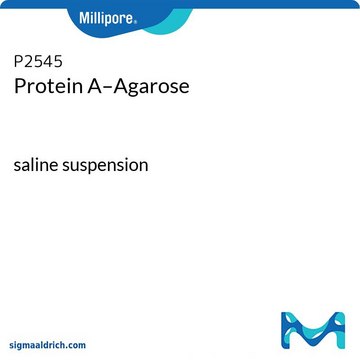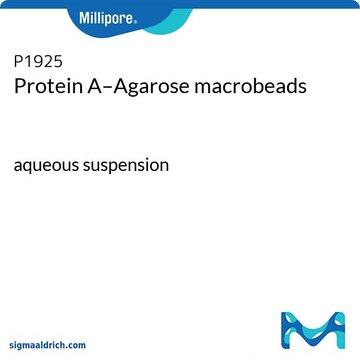P9269
Protein A–Agarose
lyophilized powder
Autenticatiper visualizzare i prezzi riservati alla tua organizzazione & contrattuali
About This Item
Prodotti consigliati
Stato
lyophilized powder
Livello qualitativo
Grado di funzionalizzazione
~2 mg per mL
Matrice
4% beaded agarose
Attivazione matrice
cyanogen bromide
Gruppi immobilizzati alla matrice
amino
Braccio spaziatore
1 atom
Capacità
≥10 mg/mL binding capacity (human IgG)
Temperatura di conservazione
−20°C
Cerchi prodotti simili? Visita Guida al confronto tra prodotti
Descrizione generale
This Protein A-Agarose product is a conjugate of Protein A to CNBr-activated agarose without an intermediate spacer arm.
Applicazioni
Protein A-agarose is used for affinity chromatography, antibody purification and characterization, and protein A, G and L resins. Protein A-agarose has been used to study the effects of protein A immunoadsorption in patients with chronic dilated cardiomyopathy as well as to study multiple sclerosis and gastric cancer.
Quantità
Swelling: 1 g swells to approx. 4 ml
Stato fisico
Supplied as lyophilized powder stabilized with lactose.
Codice della classe di stoccaggio
11 - Combustible Solids
Classe di pericolosità dell'acqua (WGK)
WGK 3
Punto d’infiammabilità (°F)
Not applicable
Punto d’infiammabilità (°C)
Not applicable
Dispositivi di protezione individuale
Eyeshields, Gloves, type N95 (US)
Scegli una delle versioni più recenti:
Possiedi già questo prodotto?
I documenti relativi ai prodotti acquistati recentemente sono disponibili nell’Archivio dei documenti.
I clienti hanno visto anche
Immune regulation in murine schistosomiasis japonica: inhibition of in vitro antigen- and mitogen-induced cellular responses by splenocyte culture supernatants and by purified fractions from serum of chronically infected mice.
K S Garb et al.
Journal of immunology (Baltimore, Md. : 1950), 129(6), 2752-2758 (1982-12-01)
Carl F Fortin et al.
International immunology, 22(8), 637-649 (2010-05-27)
Polymorphonuclear neutrophils (PMNs) are the first line of defense against invading organisms in humans; in addition, PMNs contribute to the linking of innate and adaptive immunity. To fulfill their biological behavior, PMNs utilize an arsenal of proteolytic enzymes, including members
Fenghua Hu et al.
The Journal of neuroscience : the official journal of the Society for Neuroscience, 28(5), 1262-1269 (2008-02-01)
Myelin-derived Nogo-A protein limits axonal growth after CNS injury. One domain binds to the Nogo-66 receptor to inhibit axonal outgrowth, whereas a second domain, Amino-Nogo, inhibits axonal outgrowth and cell adhesion through unknown mechanisms. Here, we show that Amino-Nogo inhibition
Stefania Trazzi et al.
PloS one, 4(6), e5832-e5832 (2009-06-09)
CENP-C is a fundamental component of functional centromeres. The elucidation of its structure-function relationship with centromeric DNA and other kinetochore proteins is critical to the understanding of centromere assembly. CENP-C carries two regions, the central and the C-terminal domains, both
Steffen Krauss et al.
Journal of virology, 83(24), 12854-12870 (2009-10-09)
Our previous work has shown that efficient evasion from type I interferon responses by human cytomegalovirus (hCMV) requires expression of the 72-kDa immediate-early 1 (IE1) protein. It has been suggested that IE1 inhibits interferon signaling through intranuclear sequestration of the
Il team dei nostri ricercatori vanta grande esperienza in tutte le aree della ricerca quali Life Science, scienza dei materiali, sintesi chimica, cromatografia, discipline analitiche, ecc..
Contatta l'Assistenza Tecnica.









